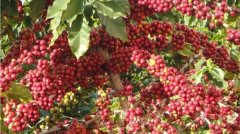Characteristics of Coffee in eight producing areas of Guatemala
1. Acatenango Valley®:
The Acatenango Valley rises to 2000 meters (6500 feet) above sea level, is densely shaded and ecologically unique, and the nearby Fuego volcano erupts constantly, making its coarse, sandy soil rich in various minerals. Temperate sea breezes from the Pacific Ocean and a well-defined seasonal climate allow coffee from this region to be sun-dried and processed in a home-style tradition that has accumulated over the years.
Acatenango Valley® cup profile:

Frag/Aroma Flavor Acidity Balance
Body: Body: Aftertaste: Overall: Overall (impression)
2. Antigua Coffee®:
Rich volcanic soil, low humidity, plenty of sunshine and cool nights are the climate characteristics of Antigua's coffee-producing areas. The valley is surrounded by three volcanoes: Agua, Fuego and Acatenango. Tierra del Fuego is one of the three most active volcanoes in Guatemala, and its frequent eruptions bring ash that makes the soil of Antigua rich in minerals. Volcanic pumice in the soil maintains moisture and helps overcome Antigua's low rainfall. In addition, the region's dense shade protects coffee plants from occasional frosts.
Antigua Coffee® cup profile

Rich wet fragrance, good balance, high sweetness, elegant taste.
3. Traditional Atitlán®
Atitlan is one of the five largest volcanic coffee producing areas in Guatemala, and its soil organic matter is the richest of the five volcanic coffee producing areas. 90% of the traditional Atitlan coffee is grown on the intensely fire-burning slopes of Lake Atitlan, where the daily breeze stirs the lake, an important factor influencing the microclimate of the region. This area has accumulated excellent planting and processing technology for a long time.
Traditional Atitlán® cup profile:

Fresh aroma, bright acidity, full body.
4. Rainforest Cobán®
Cobain is cloudy, rainy and cool all year round. The vast majority of rainforest Cobain coffee is grown in the region's distinctly undulating, foggy mountains, heavily influenced by limestone and clay from the Atlantic Basin. Cobain has two seasons: rainy and rainy.
Rainforest Cobán® cup profil

5. Fraijanes Plateau®:
The area is volcanic soil, high altitude, abundant rainfall, humidity changes greatly. Ash from Pacaya, Guatemala's most active volcano, provides important minerals for the region's soils. The dry season sunshine is abundant, although the morning fog, dew is big, but dissipates quickly. As a result, 100 per cent of the coffee in the region is sun processed.
Fraijanes Plateau® cup profile

Acidity is bright, consistent, aroma sufficient, mellow and delicate.
6. Highland Huehue®:
Of Guatemala's three major non-volcanic coffee producing areas, the Picotenango Uplands have the driest climate and the highest elevation. Dry hot winds from Mexico's Tehuantepec plateau protect coffee from frost and coffee can be grown to plots of 2000 meters (6500 feet). Because of its remoteness, all coffee farmers have to process their own coffee, but fortunately there are so many streams in the area that small processing plants can be set up almost anywhere.
Highland Huehue® cup profile

High acidity, pleasant, high body, with a wine finish.
7. New Oriente®:
Coffee in this area has been grown exclusively by small farmers since the 1950s, and today every farmer in the mountains is a coffee-producing unit. This region, once the most remote and poorest in Guatemala, is now showing signs of life. Rainy, cloudy, New Oriental ancient era is a volcanic area, soil volcanic metamorphic evolution, rich in minerals, nutrition balance, different from other volcanic coffee producing areas.
New Oriente® cup profile

The palate is well-balanced, full-bodied, with chocolate notes.
8. Volcanic San Marcos®:
San Marco has the hottest climate of Guatemala's eight coffee-producing regions, with rainfall of up to 200 inches (5, 000mm). The rainy season is earlier than in other areas, and coffee trees bloom earlier. As in other remote areas of Guatemala, volcanic San Marco coffee is grown and processed by small farmers. Due to frequent rains during the rainy season, most coffees are pre-dried in the sun and then dried in Guardiola dryers.
Volcanic San Marcos® cup profile

Aroma and taste with subtle floral, acidity, good body.
Important Notice :
前街咖啡 FrontStreet Coffee has moved to new addredd:
FrontStreet Coffee Address: 315,Donghua East Road,GuangZhou
Tel:020 38364473
- Prev

Coffee beans can be preserved in the following ways
Roasted coffee beans are easily exposed to oxygen in the air to produce oxidation, which deteriorates the oil quality, volatilizes and disappears aroma, and then accelerates deterioration through temperature, humidity, sunshine and so on.
- Next

Brief introduction of Ethiopian Coffee
Ethiopia is the hometown of Arabica coffee, and it is in the forests of Kaffa that you can see wild Arabica coffee. In Ethiopian, coffee is called "Bun" or "Buna". Coffee beans (coffee bean) may be translated from "Kaffa Bun".
Related
- Guji coffee producing area of Guji, Ethiopia: Humbela, Shakiso, Wulaga
- What is the most expensive variety of Qiloso in BOP multi-variety group?
- How to store the coffee beans bought home?
- Why are Yemeni coffee beans so rare now?
- Ethiopian Sidamo all Red Fruit Sun Sun Santa Vini Coffee beans
- SOE is mostly sour? What does it mean? Is it a single bean? what's the difference between it and Italian blending?
- Is Italian coffee beans suitable for making hand-brewed coffee?
- How to choose coffee beans when making cold coffee? What kind of coffee beans are suitable for making cold coffee?
- Just entered the pit to make coffee, what kind of coffee beans should be chosen?
- Can only Japan buy real Blue Mountain Coffee? What are authentic Jamaican Blue Mountain coffee beans?

